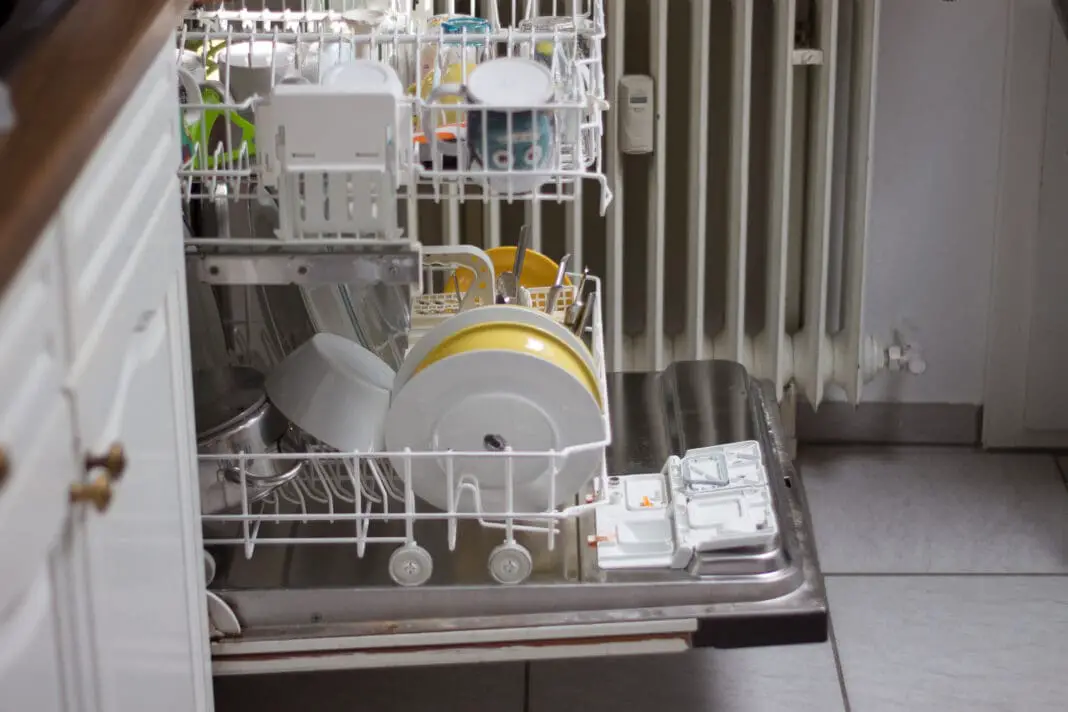Opening the dishwasher after a full cycle only to find plates still coated with food residue is one of modern life’s most annoying experiences. Despite spending hundreds or even thousands on what should be a time-saving appliance, many people find themselves rewashing dishes by hand anyway. The problem isn’t necessarily that dishwashers are bad machines, but rather that several common mistakes prevent them from doing their job properly.
Your dishwasher filter is completely clogged
Most dishwashers manufactured after 2010 have removable filters that trap food particles to prevent them from recirculating onto clean dishes. These filters are typically located at the bottom of the dishwasher tub, secured with a twist-off cap. When filters become clogged with grease, food debris, and mineral deposits, dirty water gets pumped back over supposedly clean dishes. The filter essentially becomes a breeding ground for bacteria and grime that spreads throughout every wash cycle.
Cleaning the filter requires removing it from the machine and rinsing it thoroughly under hot water. For stubborn buildup, soaking it in hot soapy water for several minutes helps break down accumulated grease and food particles. A soft brush can gently scrub away remaining debris before reinstalling. Manufacturers recommend cleaning filters at least once monthly, though households that run frequent loads may need weekly cleaning to maintain optimal performance.
Spray arms are blocked with debris
The spinning spray arms underneath and above dishwasher racks distribute pressurized water through tiny holes to blast away food particles. When these holes become clogged with mineral deposits, small food pieces, or grease buildup, water pressure drops significantly and cleaning effectiveness plummets. Even partial blockages can create uneven spray patterns that leave entire sections of dishes unwashed. Many people never think to check these critical components until washing performance becomes noticeably poor.
Removing spray arms varies by model, but most either lift out easily or require removing a single screw. Once removed, running them under hot water reveals which holes are blocked. A toothpick or thin wire works perfectly for clearing individual holes without damaging the plastic. For thorough cleaning, soaking spray arms in white vinegar for two hours dissolves mineral deposits that regular scrubbing can’t remove. This simple maintenance task can dramatically improve cleaning performance immediately.
Water temperature is too low for effective cleaning
Dishwashers require water heated to at least 120 degrees Fahrenheit to properly dissolve grease, activate detergent enzymes, and sanitize dishes effectively. Many water heaters are set to lower temperatures for safety reasons, especially in homes with small children. When lukewarm water enters the dishwasher, detergent doesn’t dissolve completely and grease remains solidified on plates and cookware. The result is dishes that appear clean but feel greasy or still have visible food particles stuck to surfaces.
Testing water temperature is simple using a candy thermometer placed in a glass of hot water from the kitchen faucet. If temperature reads below 120 degrees, adjusting the water heater setting usually solves the problem. Running hot water at the kitchen sink for two minutes before starting the dishwasher ensures hot water reaches the appliance immediately rather than starting with cold water sitting in pipes. This simple step can mean the difference between sparkling clean dishes and disappointing results.
You’re using the wrong detergent or wrong amount
Not all dishwasher detergents work equally well in different water conditions, and using too much or too little creates its own problems. Hard water requires detergents with built-in water softeners, while soft water areas need gentler formulations to prevent excessive sudsing. Using regular dish soap instead of dishwasher-specific detergent creates so many suds that the machine can’t rinse properly, leaving soapy residue on everything. Even premium detergents fail when used in incorrect quantities for specific load sizes and soil levels.
Checking the dishwasher manual reveals manufacturer recommendations for detergent types and amounts based on water hardness. Rinse aid is equally important but often overlooked, helping water sheet off dishes rather than forming spots and film. Many people rely on combination tablets claiming to include rinse aid, but separate rinse aid dispensers provide better results. Testing different detergent brands and adjusting quantities based on actual results often reveals the perfect combination for specific machines and water conditions.
Dishes are loaded incorrectly and blocking water flow
Proper loading technique directly impacts cleaning effectiveness, yet most people treat dishwashers like storage containers where everything gets crammed wherever it fits. Plates stacked too closely together prevent water from reaching all surfaces, while large pots and pans can block spray arms from rotating freely. Silverware nested together in the same direction allows spoons and forks to shield each other from water contact. Even the orientation of bowls and cups matters since items facing the wrong direction can trap dirty water instead of allowing it to drain away.
Following manufacturer loading guidelines seems obvious but makes an enormous difference in results. Plates should face toward the center where spray arms are located, with enough space between items for water circulation. Tall items like cutting boards or cookie sheets should never block the detergent dispenser from opening completely. Silverware loads best with some pieces pointing up and others pointing down to prevent nesting while ensuring everything gets properly cleaned. Taking an extra minute to load thoughtfully pays off with consistently better results.
You’re pre-rinsing dishes too thoroughly
Counter-intuitively, completely rinsing dishes before loading them into the dishwasher can actually result in poorer cleaning performance. Modern dishwasher detergents contain enzymes specifically designed to break down food proteins and starches. These enzymes need something to work on, and when dishes are spotlessly pre-rinsed, the enzymes have nothing to target and may not activate properly. Additionally, dishwashers with soil sensors rely on detecting food particles to determine appropriate wash intensity and duration.
The best approach involves scraping away large food particles while leaving some residue for the detergent to tackle. A rubber spatula or spoon works perfectly for removing chunks without completely cleaning plates. This gives dishwasher detergents the optimal amount of soil to work with while preventing large pieces from clogging filters or spray arms. Older dishwashers may require more thorough pre-rinsing, but most machines manufactured in the last decade perform better with moderately soiled dishes than with pre-cleaned ones.
Wrong wash cycle selection for your load type
Most people default to using the same wash cycle for every load, regardless of how dirty the dishes are or what types of items they’re cleaning. Quick wash cycles designed for lightly soiled items simply don’t have enough time or water pressure to tackle baked-on food or greasy cookware. Conversely, running heavily soiled cycles for delicate glassware wastes energy and may cause damage. Each cycle uses different combinations of water temperature, pressure, and duration optimized for specific cleaning challenges.
Learning which cycles work best for different situations improves results dramatically while potentially saving energy and water. Heavy-duty cycles excel at cleaning pots and pans with stubborn residue, while delicate cycles protect fine china and crystal. Normal cycles handle everyday loads of moderately soiled dishes effectively. Some dishwashers include sensor wash options that automatically adjust cycle parameters based on soil levels detected during the initial rinse. Understanding these options and matching them to actual cleaning needs ensures optimal performance every time.
Soap dispenser door isn’t opening properly
The detergent dispenser door must open at the precise moment during the wash cycle when conditions are optimal for cleaning. When this door is blocked by large items, damaged springs, or accumulated grime, detergent gets released at the wrong time or not at all. Sometimes the door opens but detergent gets trapped in the compartment instead of dissolving into the wash water. Even minor issues with the dispenser mechanism can result in dishes that receive only a water rinse without any cleaning agents.
Checking the dispenser involves examining both the door mechanism and the area around it for obstructions. Large plates or mixing bowls positioned too close can prevent the door from opening completely. Cleaning the dispenser compartment with hot water and vinegar removes built-up detergent residue that might prevent proper operation. If the spring mechanism appears damaged or the door gasket is cracked, replacement parts restore proper function. Regular inspection of this critical component prevents mysterious cleaning failures that leave homeowners frustrated with their dishwasher’s performance.
Hard water deposits are coating everything inside
Hard water contains dissolved minerals that gradually build up on dishwasher components, creating a white, chalky film that interferes with cleaning effectiveness. These mineral deposits coat spray arm holes, clog filters faster, and leave spots on glassware that make everything look dirty even when it’s technically clean. The minerals also interfere with detergent performance by binding with cleaning agents before they can work on food soils. Over time, hard water damage becomes so extensive that even properly functioning dishwashers struggle to clean effectively.
Regular descaling with white vinegar helps dissolve mineral buildup throughout the dishwasher’s internal components. Running an empty cycle with three cups of vinegar placed in the bottom of the tub removes deposits from areas that manual cleaning can’t reach. For severe hard water problems, installing a water softener system addresses the root cause rather than just treating symptoms. Some dishwashers include built-in water softening systems that require periodic refilling with salt specifically designed for this purpose.
These common issues explain why so many households struggle with dishwasher performance despite having relatively new machines. Most problems stem from simple maintenance oversights or user habits rather than mechanical failures requiring expensive repairs. Taking time to address these root causes transforms frustrating dishwashing experiences into the time-saving convenience that modern appliances should provide.

